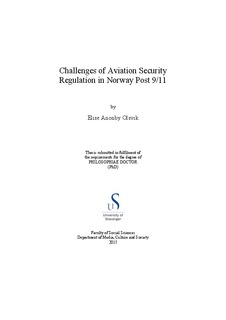| dc.description.abstract | The 9/11 terrorist attacks in the USA had wide-ranging consequences for security issues in Western societies. Within civil aviation, the attacks became grim evidence that the security system constructed to prevent intentional attacks was deficient. In Europe, the European Union took on the responsibility to gather European civil aviation security under one banner, relieving the EU members’ national legislation on aviation security, uniting it through implementing one common supranational regulation for all EU countries.
As a non-EU member, Norway was obligated by the European Economic Area Agreement (EEA Agreement) to implement the same regulations as the EU countries to avoid being banned from the One-Stop Security regime that had been in effect prior to the 9/11 attacks. The bearing principle in the One-Stop Security regime is that any passenger who is security screened at any entry point within the system will forego any new screenings whilst travelling within the system. Therefore, every airport participating in this system must, regardless of size, implement measures that ensure that the EU regulative level is maintained at the same predefined level. In order to achieve this, a highly prescriptive regulation was developed, based on main documents from the International Civil Aviation Organisation (ICAO) that had previously been applied as guiding documents for the national civil aviation regulations and legislation. These documents had previously provided recommendations that each country was only obliged to report deviations from, but after 9/11 these became mandatory in the new EU regulation.
This thesis aims at describing the consequences of this regulatory transition by investigating the following research problem: “What are the consequences of implementing EU security regulation in the Norwegian civil aviation system?”
The main aim is, thus, to discover possible consequences of the regulatory system instated post 9/11, both on the authority and airport levels, connecting regulatory types to organisational challenges.
In order to study these issues, a charting of the Norwegian civil aviation system and the regulatory landscape was performed by interviewing the main actors and authorities within Norwegian civil aviation. Thereafter, fieldworks were conducted at three different sized airports. In addition, to understand the findings of the Norwegian implementation, a comparative case was made by conducting interviews with key actors in the Icelandic civil aviation system. This comparison was intriguing since Iceland, like Norway, is obligated through the EEA Agreement, yet Iceland chose a different implementation than Norway.
Airport security can be defined as a High Reliability Organisation (HRO), as defined by Weick et al. (Weick, Sutcliffe, & Obstfeld, 1999, p. 90). These are organisations that operate in a highly unforgiving environment which, in case of errors, has the potential for disastrous outcomes. As security is threatened by different kinds of risks than those with which HRO theory and literature normally have been occupied, I argue that this has less importance when the purpose is to investigate which factors produce reliable outcomes in organisations, regardless of whether the threats are intentionally caused (security) or accidentally caused (safety). Thus, studies on security can be profitably incorporated into the vast literature on organisational safety and reliability.
The findings from this study reveal a high degree of constraint at the airport level, both among leaders and employees, caused by the construction of the security regulation and its implementation. Possibilities for action, through influence and involvement in regulatory processes, decreased exponentially with the increase in details and prescription after 9/11.
Possibilities for action, or ‘space for action’ as it has been labelled in this thesis, is what facilitates the organisation to adapt and adjust regulation into the context. Seen in relation to HRO principles, limited possibilities for action may lead to mindlessness and, thus, threaten the overall reliability in an organisation.
Consequences will necessarily follow a groundbreaking event like what occurred on 9/11. Not only did the security system demonstrate its limitations, but the symbolic value was also high. Consequently, this will affect people’s perception of the trustworthiness of the system. Authoritative action will be essential, and speed will demonstrate vigour. The regulatory work inaugurated in the hours following the terrorist act on 9/11 has unquestionably heightened the security level for civil aviation. However, more than a decade later, it is possible to explore the transition in hindsight to see its consequences in the actual context of the airport. | nb_NO |

